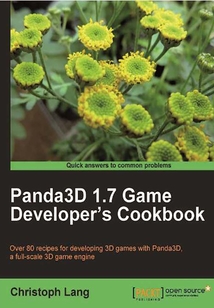舉報 

會員
Panda3d 1.7 Game Developer's Cookbook
最新章節:
Index
Thisisacookbookwithover80recipesofferingsolutionstocommongamedevelopmentproblemswithPanda3Dwithexplainedsamplecodeandscreenshotsaddedin.IfyouareadeveloperwithexperienceinPython,Panda3D,andoptionallyC++andshadinglanguagesandyouarelookingforquickandeasytointegratesolutionstocommongamedevelopmentproblemswithPanda3D,thisbookisforyou.
目錄(122章)
倒序
- 封面
- 版權信息
- Credits
- About the Author
- About the Reviewers
- www.PacktPub.com
- Support files eBooks discount offers and more
- Preface
- What this book covers
- What you need for this book
- Who this book is for
- Conventions
- Reader feedback
- Customer support
- Chapter 1. Setting Up Panda3D and Configuring Development Tools
- Introduction
- Downloading and configuring NetBeans to work with Panda3D
- Configuring Visual Studio 2008 to work with Panda3D
- Understanding Panda3D's runtime configuration options
- Setting up the game structure
- Building Panda3D from source code
- Chapter 2. Creating and Building Scenes
- Introduction
- Loading terrain
- Loading and attaching sounds to objects
- Creating a scene using C++
- Adding an additional camera
- Inspecting and modifying the scene
- Modifying the scene graph
- Moving objects based on time
- Controlling actions using intervals
- Making animations fit to intervals
- Making objects follow a predefined path
- Making the camera smoothly follow an object
- Generating geometry at runtime
- Loading data asynchronously
- Chapter 3. Controlling the Renderer
- Introduction
- Changing a model's render attributes
- Adding an alpha mask to a texture
- Creating a splitscreen mode
- Controlling the rendering order
- Using multiple displays
- Chapter 4. Scene Effects and Shaders
- Introduction
- Adding lights and shadows
- Using light ramps
- Creating particle effects
- Animating textures
- Adding ribbon trails to an object
- Creating a flashlight effect
- Making objects reflect the scene
- Adding a custom shader generator
- Applying a custom Cg shader
- Chapter 5. Post-Processing and Screen Space Effects
- Introduction
- Adding built-in post-processing effects
- Building custom effects
- Adding a scanline and vignette effect
- Adding a color grading effect
- Adding a depth of field effect
- Building a deferred rendering pipeline
- Chapter 6. 2D Elements and User Interfaces
- Introduction
- Rendering text to the screen
- Rendering images to the 2D layer
- Playing a movie file
- Creating an interactive user interface
- Making the user interface data-driven using XML
- Chapter 7. Application Control
- Introduction
- Toggling window and fullscreen modes
- Controlling game state
- Decoupling modules using events
- Handling events more elegantly
- Managing recurring tasks
- Chapter 8. Collision Detection and Physics
- Introduction
- Using the built-in collision detection system
- Using the built-in physics system
- Using the ODE physics engine
- Using the PhysX physics engine
- Integrating the Bullet physics engine
- Chapter 9. Networking
- Introduction
- Downloading a file from a server
- Using assets hosted on a server
- Sending high scores to a server
- Establishing a network connection
- Sending and receiving custom datagrams
- Synchronizing object state between server and client
- Chapter 10. Debugging and Performance
- Introduction
- Debugging Python code
- Debugging C++ code
- Using the PStats tool for finding performance bottlenecks
- Improving performance by flattening scenes
- Implementing performance critical code in C++
- Chapter 11. Input Handling
- Introduction
- Handling keyboard and mouse input
- Implementing an abstraction layer for supporting multiple input methods
- Handling input from an Xbox 360 controller
- Recording and simulating user input
- Reading audio data from a microphone
- Reading video data from a webcam
- Reading input data from a network
- Chapter 12. Packaging and Distribution
- Introduction
- Packing assets into multifiles
- Creating a redistributable game package
- Advanced package creation and hosting
- Embedding a game into a website
- Using website and plugin interoperability
- Chapter 13. Connecting Panda3D with Content Creation Tools
- Introduction
- Setting up the Blender export plugin
- Exporting models from Blender
- Generating model files programmatically
- Using the "Pview" tool to preview models
- Compressing and converting model files using pzip and egg2bam
- Index 更新時間:2021-04-09 21:22:12
推薦閱讀
- 中文版Photoshop CS6完全使用手冊(超值版)
- PS是這樣玩的:輕松掌握 Photoshop 通關秘籍
- UG NX10.0從新手到高手
- Word-Excel-PowerPoint 2010三合一從新手到高手(超值版)
- 設計模式之禪(第2版)
- Autodesk Ecotect Analysis 2011綠色建筑分析應用
- 移動App測試的22條軍規
- 微信小程序開發入門與實踐
- PHP應用開發與實踐
- 巧學巧用Flash CS6制作動畫
- 構筑敏捷的開發團隊:微軟Visual Studio 2010實戰兵法
- Maya 2015從入門到精通
- Photoshop-CorelDRAW 基礎培訓教程
- 藝術二維碼設計與制作完全攻略 PHOTOSHOP+ILLUSTRATOR+FLASH
- Android APP開發實戰:從規劃到上線全程詳解
- 用友(T3)會計信息化軟件考前12小時
- MATLAB 2008全程指南
- AutoCAD機械繪圖(修訂版)
- 深入解析Android 5.0系統
- UG NX6完全自學手冊
- 3ds Max/After Effects 印象 影視包裝技術精粹(第2版)
- 中文版CorelDRAW X6學習手冊
- SAS統計分析與應用實例
- 廣聯達BIM算量大賽實訓圖集
- MATLAB神經網絡超級學習手冊
- UG NX 5中文版模具設計技法與典型實例精講
- Adobe Camera Raw攝影后期完全寶典(Photoshop CC 通用版)
- 了不起的3D打印
- 詳解MATLAB圖像函數及其應用
- CAD競賽習題集

